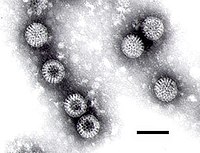
MS2 and Qβ bacteriophages reveal the contribution of surface hydrophobicity on the mobility of non‐enveloped icosahedral viruses in SDS‐based capillary zone electrophoresis
Sign Up to like & getrecommendations! Published in 2018 at "ELECTROPHORESIS"
DOI: 10.1002/elps.201700352
Abstract: SDS is commonly employed as BGE additive in CZE analysis of non‐enveloped icosahedral viruses. But the way by which SDS interacts with the surface of such viruses remains to date poorly known, making complicate to… read more here.
Keywords: icosahedral viruses; enveloped icosahedral; non enveloped; surface hydrophobicity ... See more keywords

Impact of the surface hydrophobicity/hydrophilicity ratio on the catalytic properties of Ni nanoparticles/MCM-41 system used in the hydrogenation of acetophenone
Sign Up to like & getrecommendations! Published in 2020 at "Catalysis Today"
DOI: 10.1016/j.cattod.2020.09.012
Abstract: Abstract Three nickel catalysts were prepared supporting pre-synthetized monodisperse Ni nanoparticles of 16 nm. As support, nanospheres of MCM-41 were used. Two batches of these supports were superficially modified by silylation treatments with different functionalizing agents:… read more here.
Keywords: hydrogenation acetophenone; impact surface; surface hydrophobicity;

Surface hydrophobicity based heat and mass transfer mechanism in membrane distillation
Sign Up to like & getrecommendations! Published in 2019 at "Journal of Membrane Science"
DOI: 10.1016/j.memsci.2019.01.057
Abstract: Abstract The investigations of how the membrane surface hydrophobicity influences the heat and mass transfer in direct contact membrane distillation (DCMD) and vacuum membrane distillation (VMD) were carried out theoretically and experimentally. Based on the… read more here.
Keywords: heat mass; surface; membrane; surface hydrophobicity ... See more keywords

Nanoscale Profiling of 2D Surface Hydrophobicity Recognition of Environmental Media via AFM Measurements in Situ.
Sign Up to like & getrecommendations! Published in 2020 at "Environmental science & technology"
DOI: 10.1021/acs.est.0c00211
Abstract: The surface hydrophobicity and its heterogeneity are essential physicochemical properties of functional materials and environmental media, which directly influence many critical processes, such as the adsorption capacity of absorbents, water/fertilizer retention of soil and oil-water… read more here.
Keywords: hydrophobicity recognition; hydrophobicity; environmental media; surface hydrophobicity ... See more keywords

Predominant Effect of Material Surface Hydrophobicity on Gypsum Scale Formation.
Sign Up to like & getrecommendations! Published in 2020 at "Environmental science & technology"
DOI: 10.1021/acs.est.0c03826
Abstract: Scale formation is an important challenge in water and wastewater treatment systems. However, due to the complex nature of membrane surfaces, the effects of specific membrane surface characteristics on scale formation are poorly understood. In… read more here.
Keywords: nucleation; surface; scale formation; surface hydrophobicity ... See more keywords

Effect of Surface Hydrophobicity on the Adsorption of a Pilus-Derived Adhesin-like Peptide
Sign Up to like & getrecommendations! Published in 2022 at "Langmuir"
DOI: 10.1021/acs.langmuir.2c01016
Abstract: Bacterial colonization of abiotic surfaces such as those of medical implants, membrane filters, and everyday household items is a process of tremendous importance for public health. Bacteria use adhesive cell surface structures called adhesins to… read more here.
Keywords: adsorption; surface hydrophobicity; pak128 144ox; surface ... See more keywords

Surface Hydrophobicity Engineering of Pt-Based Noble Metal Aerogels by Ionic Liquids toward Enhanced Electrocatalytic Oxygen Reduction.
Sign Up to like & getrecommendations! Published in 2023 at "ACS applied materials & interfaces"
DOI: 10.1021/acsami.3c02101
Abstract: Modulating the surface properties of electrocatalysts with ligands could effectively regulate their catalytic properties, while limited in-depth understanding of the surface ligands restricted their rational combination. Herein, ionic liquids (ILs) with different lengths of hydrophobic… read more here.
Keywords: surface hydrophobicity; noble metal; surface; metal aerogels ... See more keywords

The Glutaredoxin Gene, grxB, Affects Acid Tolerance, Surface Hydrophobicity, Auto-Aggregation, and Biofilm Formation in Cronobacter sakazakii
Sign Up to like & getrecommendations! Published in 2018 at "Frontiers in Microbiology"
DOI: 10.3389/fmicb.2018.00133
Abstract: Cronobacter species are foodborne pathogens that can cause neonatal meningitis, necrotizing enterocolitis, and sepsis; they have unusual abilities to survive in environmental stresses such as acid stress. However, the factors involved in acid stress responses… read more here.
Keywords: formation cronobacter; biofilm formation; sakazakii; formation ... See more keywords

Palmitic Acid Inhibits the Virulence Factors of Candida tropicalis: Biofilms, Cell Surface Hydrophobicity, Ergosterol Biosynthesis, and Enzymatic Activity
Sign Up to like & getrecommendations! Published in 2020 at "Frontiers in Microbiology"
DOI: 10.3389/fmicb.2020.00864
Abstract: Biofilm is the fortitude of Candida species infections which eventually causes candidiasis in human. C. tropicalis is one of the predominant Candida species commonly found in systemic infections, next to C. albicans. In Candida species,… read more here.
Keywords: palmitic acid; surface; virulence factors; cell surface ... See more keywords

Modification of Surface Hydrophobicity of PLA/PE and ABS/PE Polymer Blends by ICP Etching and CFx Coating
Sign Up to like & getrecommendations! Published in 2020 at "Materials"
DOI: 10.3390/ma13235578
Abstract: The flow regime inside the channel of 3D printed microreactors is defined by the surface properties of the channel walls. Polylactide (PLA) and acrylonitrile/butadiene/styrene (ABS) are two polymers that are the most common in additive… read more here.
Keywords: surface; polymer; cfx coating; polymer blends ... See more keywords

Towards the Hydrophobization of Thermoplastic Starch Using Fatty Acid Starch Ester as Additive
Sign Up to like & getrecommendations! Published in 2022 at "Molecules"
DOI: 10.3390/molecules27196739
Abstract: To bring surface hydrophobicity to thermoplastic starch (TPS) materials for food packaging, fatty acid starch esters (FASE), specifically starch tri-laurate, were incorporated into TPS formulations. A total of three different ratios of FASE (2%, 5%… read more here.
Keywords: surface hydrophobicity; thermoplastic starch; starch; fase ... See more keywords